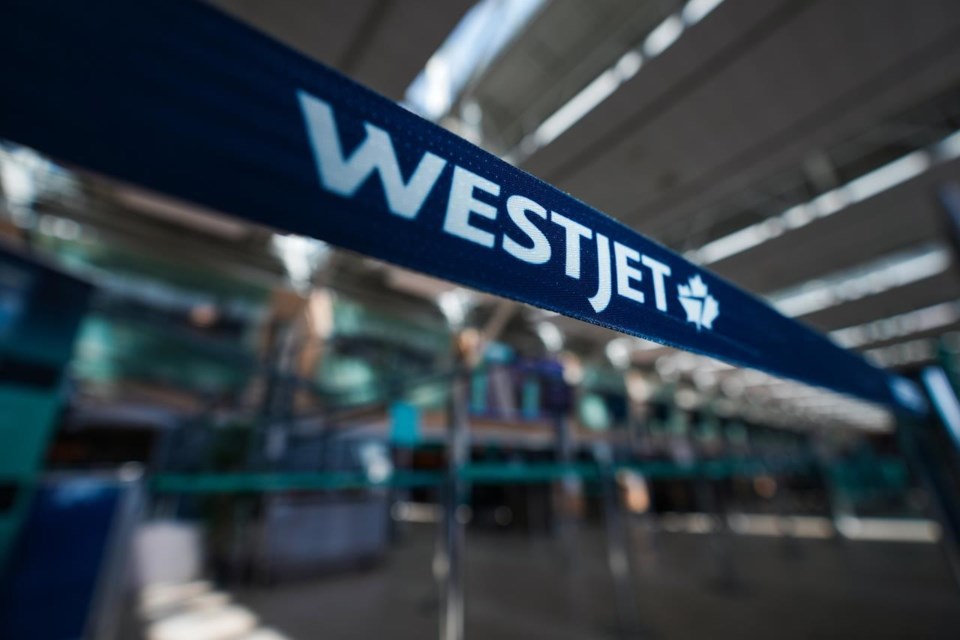WestJet faces indefinite delays on dozens of new aircraft deliveries after a panel blowout on a Boeing 737 Max plane last month prompted a halt to greater production at the U.S. aircraft maker.
The Calgary-based carrier bought 42 Boeing 737 Max 10 jetliners in 2022, with options for 22 more — on top of nearly two dozen earlier Max orders still in the pipeline.
The multibillion-dollar deals were slated to bolster WestJet’s fleet by at least 65 planes — 50 of them Max 10s — by 2029 in a move the airline called a "game-changer" that would reduce fuel costs and “underpin” its growth.
However, the Max 10 has yet to receive final certification and, after the panel emergency, U.S. regulators said they would halt production expansion at Boeing until safety concerns were sufficiently addressed.
The Federal Aviation Administration grounded all 737 Max 9s for inspection and launched a probe after a panel known as a door plug tore away from the fuselage of an Alaska Airlines plane while in flight on Jan. 5, leaving a refrigerator-sized hole in the cabin wall and prompting an emergency landing.
As of Feb. 5, 94 per cent of the 144 Max 9s flown by United Airlines and Alaska Airlines — two-thirds of all Max 9s in operation globally — had been cleared to return to service, according to the FAA.
WestJet said it could handle the production turbulence.
"We continue to work closely with Boeing on all aspects of aircraft delivery and timelines. We believe our order book and fleet planning have the built-in flexibility to support WestJet’s growth plans," spokeswoman Madison Kruger said in an email.
The Max 10 is the largest plane in the latest line of 737s and offers 20 per cent fewer carbon emissions per passenger than the previous generation. Fleet rejuvenation is essential to ensuring efficiency, bringing down costs — jet fuel and labour are airlines' two biggest expenses — and showing a commitment to green targets.
"The ability of WestJet to do that is compromised by Boeing," said John Gradek, who teaches aviation management at McGill University.
“The older the fleet becomes, the more expensive and the less efficient it becomes," he said.
“If that airplane isn't going to see the light of day for years — if ever — because of what's going on, the plans that WestJet has for fleet renewal are going to be in jeopardy."
The 65 new aircraft ordered by WestJet amount to nearly 40 per cent of its current fleet, according to Airfleets.net. Many of them would likely replace some of the 88 airliners from the previous generation of 737 planes over time.
The list price of the 42 Max 10s ordered in 2022 totalled $7.6 billion, though large purchases typically come with major discounts.
At the time, both Boeing and WestJet stressed the importance of the deal.
"The 737-10 will be a game changer, with one of the lowest costs per seat among mid-range aircraft. This will foster our low-cost positioning and affordability for Canadians," said Stan Deal, who heads Boeing's commercial airlines division, in a September 2022 statement.
WestJet said then that the planes would "strengthen the airline’s presence in Western Canada and underpin growth in transcontinental and leisure offerings" from Eastern Canada.
The carrier faces challenges beyond delivery delays. A pair of no-frills airlines based in Alberta — Flair Airlines and Lynx Air — continue to compete with WestJet, following its wind-down of budget subsidiary Swoop in October. A new collective agreement with pilots has also raised labour costs for Canada's second-largest carrier, all as battles for a bigger share of domestic and sunshine destination traffic drag on.
Other Boeing partners are likely to feel the impact of the FAA's order, which caps 737 production at 38 per month until the regulator is "satisfied that the quality control issues" are resolved. Boeing had initially planned to hike production to 42 per month in 2024.
"The long-term implications of the grounding are potential delivery delays and a further push-out of the Max-10 certification," wrote analyst Savanthi Syth of Raymond James in a note to investors on Jan. 31.
This report by The Canadian Press was first published Feb. 12, 2024.
Christopher Reynolds, The Canadian Press



